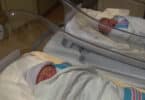Scientists have recently reported that there are different types of twins, including identical, fraternal, and a new category called semi-identical twins.
A fascinating discovery was made when researchers found twins who are identical on their mother’s side but share only half of their genes from their father. This occurred when two sperm cells fertilized one egg, a rare event in itself, and then split into two embryos.
Geneticist Vivienne Souter, from the Banner Good Samaritan Medical Center, describes these twins as having a similarity that falls between identical and fraternal twins. This raises the question of whether our current understanding and classification of twins is too simplistic.
This finding was published in the Journal of Human Genetics.
To provide context, identical twins are created when one fertilized egg splits into two embryos. They share a placenta and are always of the same sex. Fraternal twins, on the other hand, come from two eggs being fertilized at the same time by different sperm. They each have their own placenta and can be the same sex or different.
The discovery of semi-identical twins came to light when one of the twins had ambiguous genitalia at birth, being born as a “true hermaphrodite” with both ovarian and testicular tissue. The other twin is anatomically male.
According to the report, these twins are now toddlers and are developing normally both physically and mentally.
Cool Twin Facts:
- The window for an egg splitting to form identical twins is very short. If the egg doesn’t split into two separate but identical eggs within the first 14 days after conception, it never will.
- The record number of fetuses in a human womb at one time is 15.
- It’s estimated that for every 400 sets of fraternal twins, one set is made up of twins who will have different fathers.
- At birth, single babies on average weigh more than twins.
- Movements such as kicking, pushing, and what looks like kissing are all documented in twins.
- Interaction between twins may be beneficial, helping to accelerate their development.
- About half of twins are delivered by Caesarean section (or C-section).







